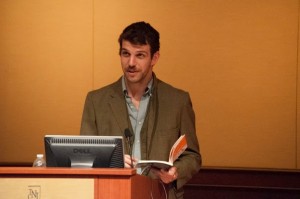Modern times are a beautifully absurd place to be for Paul Leagult. Hailing from the postmodernist enclaves of Brooklyn, the critically acclaimed poet and translator offered a reading of his work to the College on Wednesday, Oct. 16. At times, Legault twisted cultural mysteries into an upside down art form — at others, his poems seemed to pilot a thought process without his listeners quite on board. Perhaps that’s the point.

Born in Ontario and raised in Tennessee, Legault had originally wanted to be a screenwriter after “renting too many movies out at Blockbuster.” He obtained his B.F.A. in screenwriting from the University of Southern California, but after dedicating so much of his spare energy to poetry, decided to earn an M.F.A. in creative writing from the University of Virginia. There was never a definitive moment when he learned how to write, as he noted in his question and answer session. It was indefinitely started but constantly pursued.
Legault has since published three books of poetry, selecting a few pieces from each to read aloud. These books include “The Madeleine Poems” in 2010, “The Other Poems” in 2011 and, most recently, 2012’s “The Emily Dickinson Reader.” The latter is a self-described “English-to-English” translation of all 1,789 Dickinson poems, only condensed into quipping, 21st century one-liners. It’s a rare combination of both Legault’s voice and the 18th century Amherst poet. The result, when flipping between the originals and Legault’s stripped-down drag translations, is enlightening and hilarious.
“I live dangerously indoors,” reads one translation. Dickinson, the formidable recluse, may have chuckled at Legault’s catty interpretations of her work.
But his adaptations were often faithfully sentimental, too. “You live very far away, but I would still like to see you,” read another. The audience swooned. There are, after all, emotional bridges between dead poets and their readers centuries later.
“I used to get angry when people tried to connect (Dickinson’s) poems to things happening in her life,” Legault said. “But then I realized that these funny things people were saying, pointing out that she had emotional feelings parallel to our own, was really useful.”
The translations within “The Emily Dickinson Reader” are succinct and relatable, but these are qualities that tend to evade Legault’s other works. His previous poetry, littered with dialogue between inanimate objects and incomplete observations, is a winding path to follow. Dogs put on hats with no conclusion, and “tiny versions of yourself (are) stacked” atop one another like a Tower of Babel in more ways than just the figurative.
It’s unclear what’s really going on in these poems. To analyze individual stanzas would be to shake a mixed bag of unsorted thoughts. And while these may be clear to Legault, both quirky and brilliant, readers may view its contents through a distant kaleidoscope.
Still, that’s modernity to Legault: a dizzy, funny, inscrutable take on the universe, far from the truth but maybe inching closer to it. And for all his topsy-turvy writing, he’s still grounded in the moment of his northeast home.
“All of my ideas come from here, this tri-state area,” Legault said. “That’s how my ideas travel but stay in one location at the same time.”






